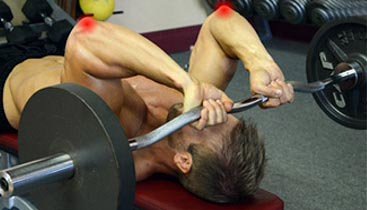THE LYING CABLE TRICEP EXTENSION (AKA “CABLE SKULL CRUSHERS”)

Lying tricep extensions (otherwise known as “skull crushers”) are one of the most common tricep isolation exercises out there and are typically performed on a flat bench using either an ez-curl bar, straight bar or dumbbells.
Although the free weight variations of this exercise are decent choices overall when it comes to direct tricep training, there are actually a couple of specific drawbacks to keep in mind here…
First off, the resistance curve of traditional free weight skull crushers does not allow you to place your triceps under consistent stress throughout the entire range of motion.

I covered this same issue last week when discussing barbell curls vs. cable curls, but because this exercise is performed in a circular motion while the force of gravity is pulling the weight down in a straight line, you won’t be able to keep the triceps fully activated from the bottom of the range all the way to the top.
In the case of lying tricep extensions, you’ll end up hitting your triceps very hard in the first half of the range (from the very bottom to about mid-way up), with the tension gradually decreasing as you extend the weight further and further up.
This can create somewhat of an awkward feel, as your triceps are hit with the greatest amount of resistance while in their weakest position, and the lowest amount of resistance while in their strongest position.
Secondly, free weight skull crushers are a very common cause of elbow pain when performed consistently over the long term.

You might be fine for a few months or years performing skull crushers as part of your workout, but most lifters find that these do catch up eventually when it comes to those all-too-delicate elbow joints.
I did outline 5 useful tips you can employ to decrease skull crusher elbow pain in a previous post, but even following these guidelines doesn’t guarantee anything.
So, what’s the solution to these two disadvantages?
Perform your skull crushers using cables instead of free weights.

The lying cable tricep extension (or “cable skull crusher”) lets you maximize the tension on your triceps throughout the entire movement without any rest, since the resistance will not only be pulling your arms downward, but also backward at the same time.
That means that even in the fully extended position where a regular free weight skull crusher would provide very little to no tension, the cable variation keeps your triceps fully activated since they’ll have to be constantly working to keep your arms in that forward position.
On top of this, most lifters find that cable skull crushers are just a “smoother” movement overall and that they don’t place the elbows under as much stress as regular free weight bars or dumbbells.
The proper form for cable skull crushers is pretty straightforward, and here’s how to do them…
The Lying Cable Tricep Extension: Proper Form
1) Position a flat bench 2-3 feet away from a cable stand and place the pulley at the very bottom of the machine.
2) Using either a straight bar, EZ-curl bar or rope (you can use whichever one you prefer), grab the attachment with a shoulder-width grip and begin with the weight just behind the top of your head.
3) From there, simply perform a regular skull crusher by extending your arms up until your elbows are fully locked out, pause briefly, and then return the weight under control back down behind your head.
4) As with all tricep extension movements, make sure to perform each rep using a smooth and controlled cadence and stick to slightly higher reps in the 8-12 range in order to minimize the pressure on your elbows.
So, if you normally perform regular free weight skull crushers but find that they’re hard on your elbows, or if you just want a variation that gives you a better contraction overall, give the lying cable tricep extension a shot.
Cable skull crushers will provide better stimulation to your triceps than the free weight variation, while at the same time reducing the chances for elbow injury.
If you found this article helpful, make sure to sign up for your FREE custom fitness plan below...




